Passifloraceae
| Passifloraceae | |
|---|---|

| |
| Passiflora caerulea | |
| Scientific classification | |
| Kingdom: | Plantae |
| Clade: | Tracheophytes |
| Clade: | Angiosperms |
| Clade: | Eudicots |
| Clade: | Rosids |
| Order: | Malpighiales |
| Family: | Passifloraceae Juss. ex Roussel[1][2] |
| Subfamilies | |
| |
| Synonyms | |
| |
The Passifloraceae are a family of flowering plants, containing about 750 species classified in around 27 genera.[1]
They include
running pop
.
Passiflora vines and Dryas iulia (among other heliconian butterflies) have demonstrated evidence of coevolution, in which the plants attempted to stop their destruction from larval feeding by the butterflies, while the butterflies tried to gain better survival for their eggs.[3]
The former
Malesherbiaceae and Turneraceae
.
Genera
Subfamily Malesherbioideae
- Malesherbia Ruiz & Pav.
Subfamily Pibirioideae
- Pibiria Maas
Subfamily Passifloroideae
|
Subfamily Turneroideae
|
Excluded genera
- Abatia Ruiz & Pav. → Salicaceae
- Aphaerema Miers → Salicaceae[6]
Phylogeny[7]
|
Violaceae | |||||||||||||||||||
| Outgroup | |||||||||||||||||||
| |||||||||||||||||||
References
- ^ a b c d "Family: Passifloraceae Juss. ex Roussel, nom. cons". Germplasm Resources Information Network. United States Department of Agriculture. 2003-01-17. Archived from the original on 2015-09-23. Retrieved 2012-01-10.
- hdl:10654/18083. Retrieved 2013-07-06.
- PMID 28563089.
- ^ "Smeathmannia R.Br. | Plants of the World Online | Kew Science". Plants of the World Online. Retrieved 7 January 2022.
- ^ "GRIN Genera of Passifloraceae". Germplasm Resources Information Network. United States Department of Agriculture. Archived from the original on 2015-09-24. Retrieved 2012-01-10.
- ^ "GRIN genera sometimes placed in Passifloraceae". Germplasm Resources Information Network. United States Department of Agriculture. Archived from the original on 2015-09-24. Retrieved 2012-01-10.
- ISSN 0024-4074.
External links
 Media related to Passifloraceae at Wikimedia Commons
Media related to Passifloraceae at Wikimedia Commons Data related to Passifloraceae at Wikispecies
Data related to Passifloraceae at Wikispecies- Passiflora Online
- The Passiflora Society International
- Passiflora Picture Gallery
